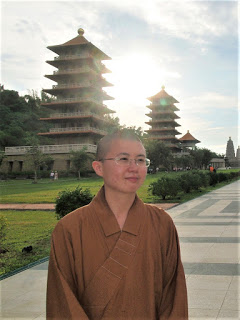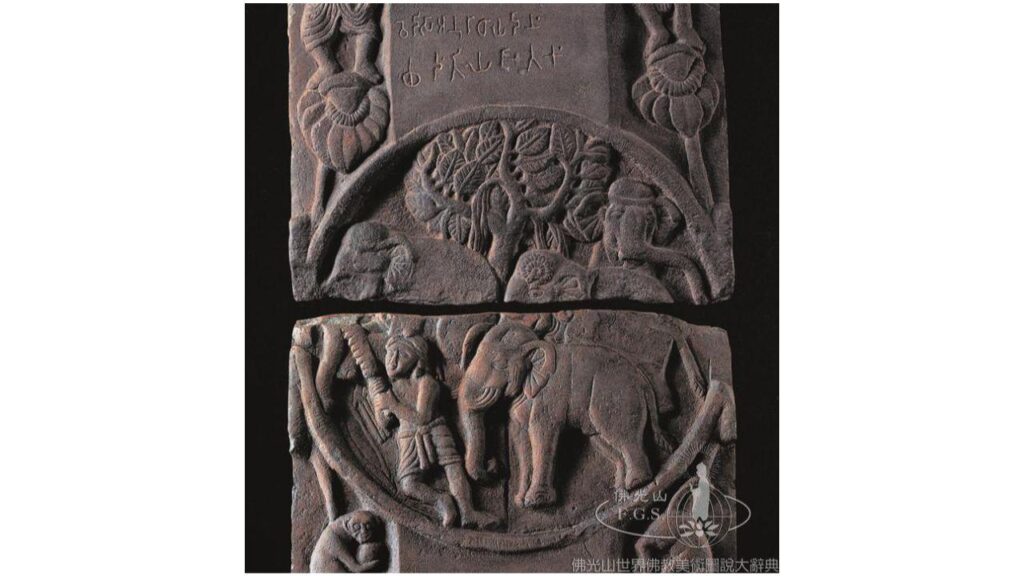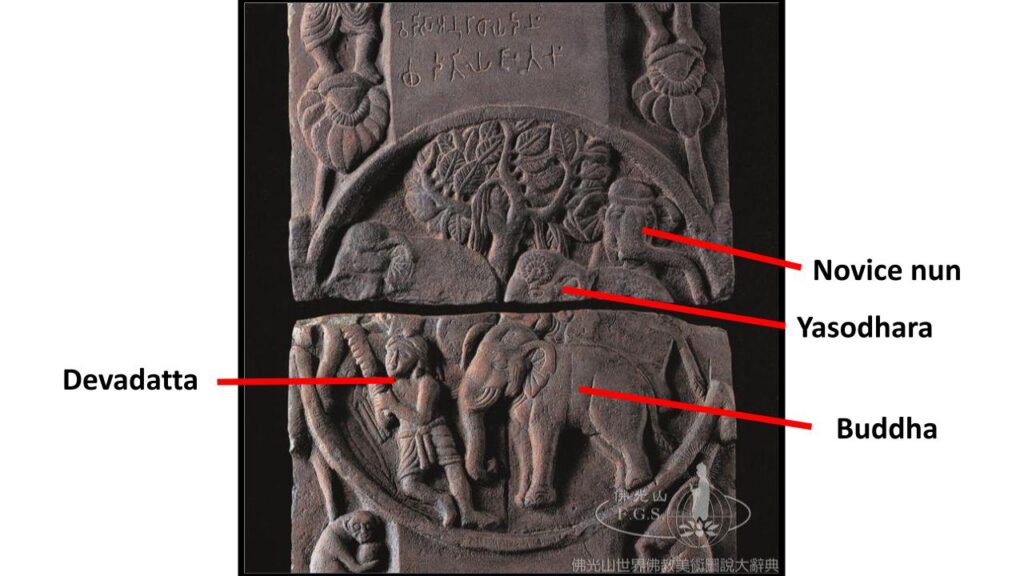
Speaker: Ven. You Lu
Fo Guang Shan Buddha Museum
I. Introduction
Hi everyone, good evening. My name is You Lu. Thank you for tuning in to the English Dharma Services. My name is You Lu. Today I would share the story of “What the Buddha did when the was an elephant” in one of his past lives.
II. Jataka Tales
Today I would like to share a Jataka story with you. Jatakas are a collection of over 500 past life stories that the Buddha recalled upon his enlightenment. Jatakas can be found in the Pali canon, the Chinese canon, as well as the Tibetan canon. In this session I will talk about the Saddanta Jataka, which is a past life story of the Buddha when he was an elephant king. In the Pali canon, this is Jataka No. 514, and you can also find this jataka in the Chinese canon, recorded in the Sutra of the Collection of Six Paramitas (六度集經) and Saṃyukta Ratnapiṭaka Sūtra. The story goes like this:

III. Saddanta Jataka
i. The Cause for Recounting the Story
Once the Buddha was teaching to an assembly at Jetavana. Among the assembly was a novice nun who was admiring the Buddha’s handsome appearance and wondered if she had in her previous lives, been a wife of the Buddha. Using her supernatural powers, she was able to recall the time when the Buddha was an elephant by the name of Saddanta, and she was his wife. But as she was recalling this past life, tears started to fall from her eyes, and seeing this, the Buddha told his past life story.
ii. The Giving of A Flower
A long time ago, there lived eight thousand elephants near the Himalayas, the chief of which was Saddanta. He was white, and measured 4-m tall and 5.5-m long. He had a trunk 2.6-m long and six tusks that were 1.4-m long. He had taken refuge in the Triple Gem and gave rise to the vow of attaining Buddhahood. From this information, we can assume that this elephant is not a usual elephant, but an elephant that repeatedly took refuge in the Triple Gem, and was keen on seeking the highest goal. The fact that Saddanta was able to lead eight thousand elephants, we can also assume that he must have considerable leadership and intelligence even though he is an animal. Scientifically, the elephant’s brain is similar to that of humans in terms of structure and complexity, and elephants display the ability to recognize themselves in a mirror, which is extremely rare in the animal kingdom. Elephants are also considered to be exceptionally smart creatures, as they have the largest brain of any land animal, and three times as many neurons as humans.
Saddanta had two wives, namely Mahasubhadda and Cullasubhadda. Once he was swimming in the lake with his wives. An elephant offered a lotus to Saddanta. Saddanta accepted the flower and presented it to Mahasubhadda. On seeing this, Cullasubhadda conceived a grudge against Saddanta. One day, Cullasubhadda offered wild fruits she had gathered to 500 pratekyabuddhas, and made a prayer, “When I pass away, may I be reborn as the royal maiden Subhadda, and on the coming of age, may I become the queen consort. Then I will charm the king and have him send a hunter to kill Saddanta.” Shortly after she made this prayer, she died.
iii. The Desire for Tusks
Cullasubhadda was then reborn as the royal maiden Subhadda and when she was of suitable age, her parents gave her in marriage to the king. She recalled her former existence and thought, “My prayer is fulfilled, and now I will have this elephant’s tusks brought to me.” Then she lay in bed and pretended to be sick.
Hearing that queen Subhadda was sick, the king came to visit her and the queen told him about a desire she wished to attain. She said, “Great king, my desire is hard to attain; I will not now say what it is, but I would have all the hunters that there are in your kingdom gathered here. Then will I tell it in the midst of them.”
The king agreed and gave orders to his ministers to gather all the hunters in the kingdom. In no time, sixty thousand hunters were gathered and brought to the queen. Then the queen spoke to them saying that she had dreamt of a white, six-tusked elephant, and she craved for his tusks, and that if she failed to get the tusks, she would die. After these words, Subhadda spotted Sonuttara among the hunters and asked for Sonuttara to complete this mission. Then Subhadda proceeded to tell Sonuttara of the whereabouts of Saddanta:
Due north, beyond seven mountains vast, One comes to Golden Cliff at last, A height by goblin forms possessed And bright with flowers from foot to crest. Beneath this goblin peak is seen A cloud-shaped mass of darkest green, A royal banyan tree whose roots Yield vigor to eight thousand shoots. There dwells invincible in might This elephant, six-tusked and white With herd eight thousand strong for fight. Their tusks to chariot poles are like, Wind-swift are they to guard or strike. Panting and grim they stand and glare, Provoked by the slightest breath of air, If they one born of man should see, Their wrath consumes him utterly.
Sonuttara on hearing this was terrified to death, and the queen Subhadda assured him saying, “Friend hunter, I had made this prayer to kill this elephant and get his tusks when I gave a gift to the pratekyabuddhas. Do not fear and rest assured that this will be fulfilled.”
Sonuttara agreed and replied, “Fair lady, I will kill the elephant and bring you his tusks.” Filled with joy, Subhadda provided him with everything that he would need on his journey.
iv. The Test of Compassion
Sonuttara set off from the city and over seven years, seven months, and seven days, he traversed 17 different tracts till he reached a mountainous region, crossed over six mountains, and climbed to the top of Golden Cliff. There he spotted an elephant, six-tusked and white. He waited for a suitable time when the elephants went to bathe, and dug a pit as a hiding place. When the pit was finished, he donned monastic robes, and taking his bow and a poisoned arrow, he stood hiding in his pit.
The time came when Saddanta was spotted to be alone. Sonuttara took his bow and aimed the arrow at Saddanta. The arrow hit Saddanta and he roared in pain. Then Sonuttara came out of the pit and upon seeing him in robes, Saddanta extinguished his anger and bowed to Sonuttara, asking, “Why did you wound me? Was it for your own advantage, or were you ordered by someone else?”
Sonuttara replied, “The Queen Subhadda had asked me to come for your tusks.”
Recognizing that this was the work of Cullasubhadda, he suffered patiently and thought, “She does not want my tusks; she wants my life! I will repay her with thoughts of kindness, such is the practice of a Bodhisattva. Even if I were to be shattered to bones and ashes, I will not go back on my promise.” He then said to Sonuttara, “Take these tusks swiftly before I am consumed by thoughts of evil.”
Saddanta, standing 4-m high, was too tall for Sonuttara. So Saddanta, bending his body towards Sonuttara, lay with his head down. Sonuttara climbed up the trunk and thrust the saw into Saddanta’s mouth. Saddanta suffered excruciating pain and his mouth was charged with blood. Saddanta, seeing how Sonuttara was unable to cut the tasks, grabbed the saw with his trunk and moved it backwards and forwards, cutting his own tusks.
Sonuttara then took the tasks, and before leaving, knowing that Sonuttara would be attacked by his herd should he be spotted, said, “Walk backward on the same trail as you came, so that my herd would not find out.” Then he added, “I gave you my tusks not because I do not value them; I gave them to you because the tusks of enlightenment are a hundred thousand times dearer to me than these tusks. May this act be the cause of attaining enlightenment!”
Sonuttara bowed down to Saddanta in gratitude, took his tools, and then walked away. When Sonuttara had gone faraway, Saddanta let out a cry and passed away.
v. The Web of Connection
Taking the tusks, Sonuttara headed back to the city and presented the tusks to the queen. When Subhadda saw the tusks, she was filled with such great sorrow that she could not endure it, and on that very day, she too died. Upon her death, she was reborn in hell.
Having told the story, the Buddha said to the assembly, “This novice nun is Cullasubbhadda, and I was Saddanta, the elephant king; Yasodhara was Mahasubhadda, and Devadatta was the hunter.”

VI. Saddanta Jataka and Precepts
In the Sutra of the Collection of Six Paramitas, this jataka was classified under precepts. There are several ideas about precepts that we can observe from this story.
The first idea about precepts is to protect our mind from unwholesomeness. In this jataka, when Saddanta encountered a life-threatening situation, he did not allow himself to give rise to anger. He was aware of the downfalls of unwholesome actions, and instead of reacting with anger, he asked Sonuttara to take his tusks swiftly before he was consumed by unwholesome thoughts. When we encounter an unreasonable situation like what Saddanta did, it is easy for us to give rise to anger and frustration, but instead Saddanta tried to protect himself from giving rise to negative thoughts. Thus precepts help us to maintain a sense of awareness in preventing harmful actions.
The second idea is about not returning a tooth for a tooth. There is a saying, “An eye for an eye, and a tooth for a tooth”, which means when one encounters harm, one reacts by seeking for compensation or retribution that is of an equal amount or degree to the injury or offense that was originally dealt. In this story, Saddanta’s tusks were taken away from him, but instead of revenging, he repaid Cullasubhadda with thoughts of giving and satisfying her desires. The Dhammapada says, “Hatred never cease through hatred in this world; through love alone they cease. This is an eternal law.” The idea of precepts in this case, is to stop the circle of unwholesome actions, and to react with positive actions.
The third idea about precepts we can learn from this story is about keeping your promise. In the story, Saddanta thought to himself, that even if he were to be shattered to bones and ashes, he will not go back on his Bodhisattva vows. As we learnt from the beginning of the story, he was an elephant who had vowed to attain Buddhahood. And in order to do attain Buddhahood, one needs to observe and stay true to the vows one has made, regardless of the situation. In the story, what made this point of keeping one’s promise so exceedingly important, is that although Saddanta was being taken advantage of and was threatened with death, he kept to his promise of not giving rise to anger, and returned hatred with kindness. If one can do this in such life-threatening situation, one can keep to one’s vows in almost any situation.
V. Three Kinds of Precepts
In Buddhism, there are basically three different forms of precepts, there are:
- Precepts for the maintenance of restraint,
- Precepts related to the cultivation of good qualities, and
- Precepts aimed at the improvement of the situation of sentient beings
In this jataka, we can also see how Saddanta performed these three forms of precepts.
As aforementioned, Saddanta upheld the precepts for the maintenance of restraint by not giving in to anger when encountering a difficult situation. He upheld the precepts related to the cultivation of good qualities by repeatedly taking refuge in the Triple Gem, and showing respect to the hunter, thinking that he was a monastic when he saw him dressed in robes. And he upheld the precepts aimed at the improvement of the situation of sentient beings by repaying Cullasubhadda’s negative deed with satisfying her desires, and also helping Sonuttara escape after he had taken his tusks.
On the contrary, there is no limit to the negativity one can perform when one does not uphold precepts. Cullasubhadda is a concrete example in this jataka. When she saw Saddanta presenting a flower to Mahasubhadda, she was jealous and schemed on killing Saddantha. If she had precepts in mind, she would have prevented herself from being a murderer. And although it seems that everything had taken place according to her plan, she ended up having to suffer in hell for her misdeeds.
On the other hand, Saddanta perfected his practice of precepts and eventually became Sakyamuni Buddha. Most people might think of precepts as restraints, and there are some who might hesitate to take the five precepts thinking that they are rules that might cause inconvenience in their lives. But in fact, precepts are more like reminders that serve to us to protect ourselves and others from negativity, and to help us deal with difficult situations in positive ways.
In Venerable Master Hsing Yun’s teaching on the Five Precepts, he says that, “In undertaking and observing the five precepts, no one will be violating others so that each and every one of us can obtain freedom together.” Thus in short, precepts are essential aids in our lives, because they protect us from harm and help us to be free.
VI. Conclusion
That’s all I would like to share for my talk tonight. Thank you again for tuning in. If you have not subscribed to this channel, please remember to hit the subscribe button for more Dharma wisdom, and also hit the bell button next to the subscribe button so you will not miss the latest updates. Thank you everyone, and goodnight!

